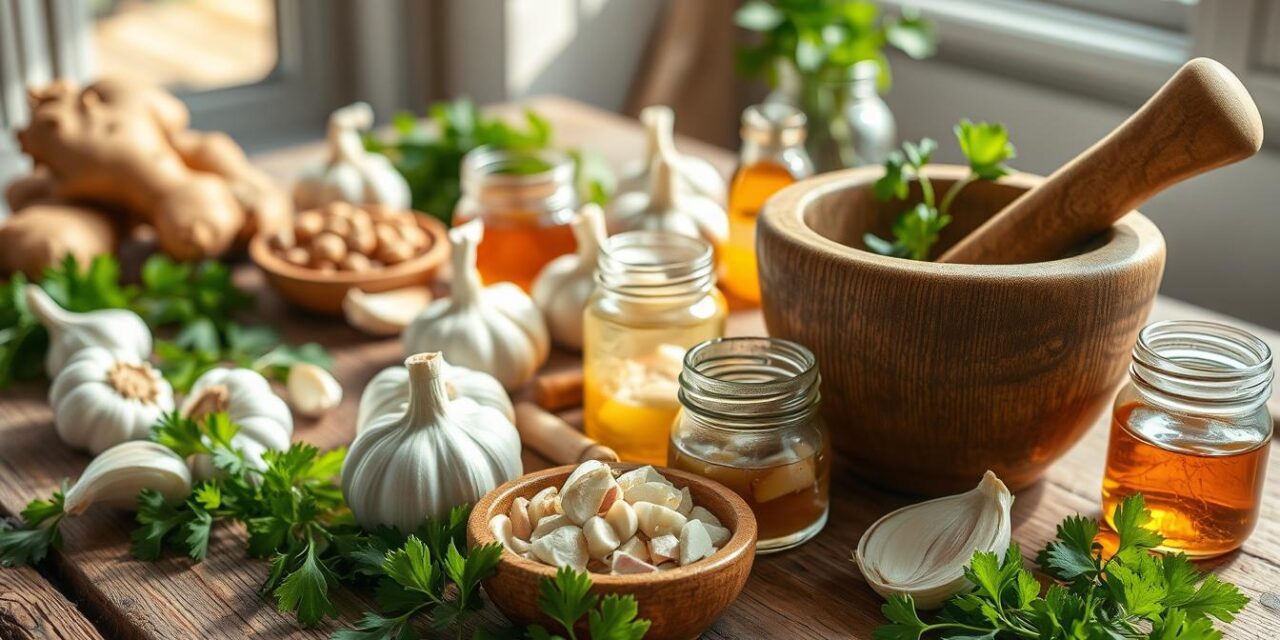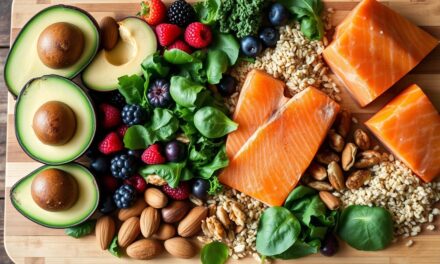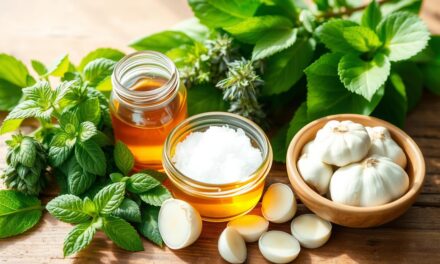Did you know garlic is a top natural antibiotic? Recent studies show one clove can fight off many harmful bacteria. This superfood has been used for centuries in traditional medicine worldwide. Its strong antimicrobial powers are now proven by science.
In this guide, we’ll look at garlic’s amazing healing powers. We’ll see how this simple plant can fight off many infections. From ancient medicine to modern science, garlic’s potential as a natural cure is impressive.
Key Takeaways
- Garlic has been used for centuries in traditional medicine across the world to treat infections and promote overall health.
- Modern research has confirmed garlic’s potent antimicrobial properties, making it a powerful natural alternative to antibiotics.
- The active compound in garlic, called allicin, is responsible for its ability to fight harmful bacteria, viruses, and fungi.
- Garlic can be used to treat a variety of common infections, from the common cold to fungal skin conditions.
- Incorporating more garlic into your diet or taking garlic supplements can help boost your immune system and improve overall wellbeing.
Understanding Garlic’s Historical Role in Traditional Medicine
Garlic has been a key part of traditional medicine worldwide. It’s been valued for its healing powers by ancient cultures and Aboriginal communities. Its long history shows why garlic is still seen as a natural remedy today.
Ancient Civilisations and Medicinal Garlic Use
In ancient Egypt, Greece, and India, garlic was used for health. It was first used around 3500 BC. In India, it was seen as a powerful herb for many health issues.
Traditional Aboriginal Medicine and Garlic
- In Australia, Aboriginal communities have used garlic-like plants for health for centuries.
- These plants were used for their ability to fight bacteria and fungi. They were part of herbal remedies.
- The knowledge of using these herbs has been passed down through generations. It shows garlic’s lasting importance in traditional medicine.
Historical Documentation of Garlic’s Healing Properties
Garlic’s uses in medicine have been recorded for ages. Hippocrates, known as the “father of medicine,” used it for many health problems. Pliny the Elder also wrote about its uses, including for wounds.
| Historical Civilization | Garlic’s Medicinal Use |
|---|---|
| Ancient Egypt | Garlic was used to treat many conditions, like parasites and heart issues. |
| Ancient China | Garlic was used in traditional Chinese medicine for its fight against bacteria and fungi. |
| Ancient Greece | Hippocrates used garlic for infections, digestive issues, and wounds. |
| Ancient Rome | Pliny the Elder noted garlic’s use for cleaning wounds and healing. |
Garlic’s role in traditional medicine is significant across cultures. Its history guides us today in understanding its health benefits. This heritage is key to its ongoing use in medicine and research.
The Science Behind Garlic’s Antibacterial Properties
Garlic is known for its natural antibacterial properties. It’s a popular natural antibiotic for fighting infections. But what makes it so effective? It’s the unique chemicals in garlic.
Allicin is at the core of garlic’s power. It’s released when garlic is crushed or chopped. This creates a strong antimicrobial agent. Allicin fights a wide range of bacteria, including Staphylococcus and Streptococcus.
Studies have shown how allicin works. It disrupts bacteria’s cell membranes, causing them to burst. Garlic’s sulfur compounds also mess with bacteria’s enzymes and metabolism. This helps kill the bacteria.
| Bacteria | Antibacterial Effect of Garlic |
|---|---|
| Staphylococcus aureus | Effective in inhibiting growth and killing the bacteria |
| Escherichia coli | Demonstrated potent antibacterial activity |
| Salmonella | Shown to be effective against various Salmonella strains |
The science backing garlic’s antibacterial properties is strong. It’s a valuable tool against many infections. As research goes on, garlic’s role in healthcare could grow even more.
Allicin: The Key Compound in Fighting Infections
Garlic’s power against infections comes from allicin. This natural substance is key to garlic’s allicin benefits. It makes garlic a strong ally in the battle against infections.
How Allicin Forms in Crushed Garlic
Allicin isn’t in whole garlic cloves. It forms when garlic is crushed or chopped. This action starts a reaction that turns alliin into allicin.
Optimal Preparation Methods for Maximum Allicin Release
- To get the most from garlic’s antimicrobial properties, let crushed garlic sit for 5-10 minutes before using it. This lets allicin fully form.
- Mincing or pressing garlic increases allicin production more than just slicing it.
- Using garlic raw or lightly cooked keeps more of its natural healing compounds. Heavy cooking reduces these benefits.
Duration of Active Compounds
Allicin and other active compounds in garlic don’t last long. They start to break down in 30-60 minutes when exposed to heat, air, or light. So, it’s best to use or eat garlic right after preparing it for the best allicin benefits.
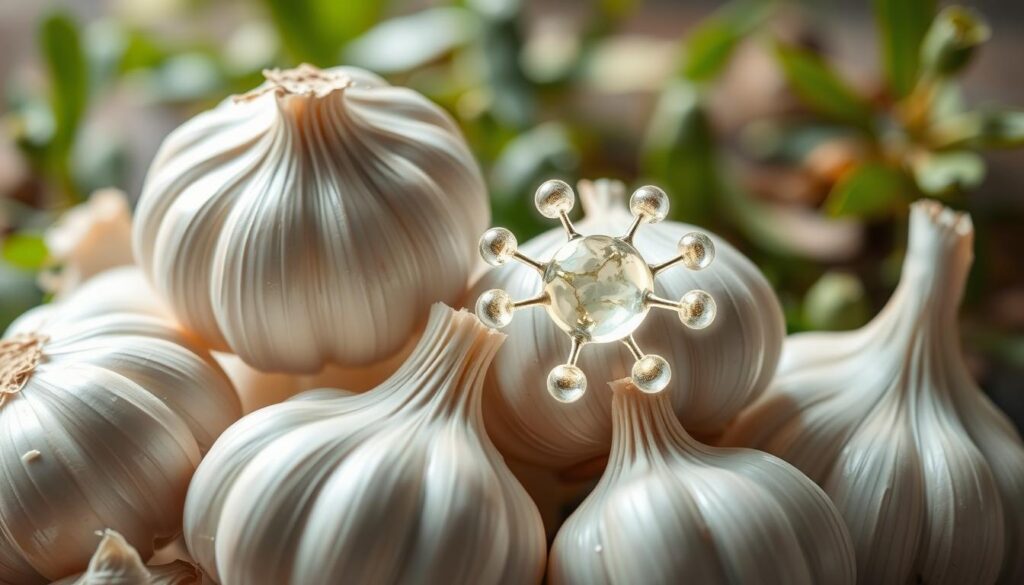
Garlic for Infection: Clinical Studies and Research
Garlic has been used for ages to fight off infections. Now, science is backing up its benefits. Many studies have looked into garlic’s power against infections.
A study in the Journal of Antimicrobial Chemotherapy showed garlic can stop bacteria and fungi. This includes strains that don’t respond to regular antibiotics. The key is allicin, which forms when garlic is crushed.
Researchers at the University of California, Los Angeles, studied garlic for colds and flu. They found garlic supplements cut down symptom days by 63% compared to a placebo.
| Study | Findings | Journal |
|---|---|---|
| Antimicrobial effects of garlic | Garlic extract inhibited the growth of both bacteria and fungi, including antibiotic-resistant strains. | Journal of Antimicrobial Chemotherapy |
| Garlic for upper respiratory infections | Participants who took garlic supplements experienced a 63% reduction in cold and flu symptom days. | University of California, Los Angeles |
These studies suggest garlic could be a good natural treatment for infections. But, we need more research to know how well it works.
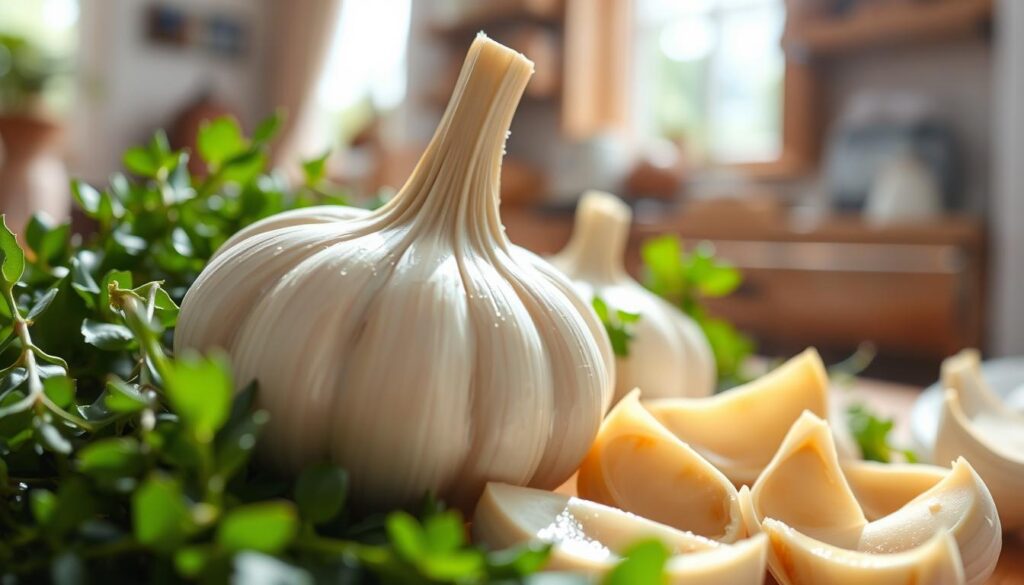
“Garlic has been used for centuries as a natural remedy, and the scientific evidence is starting to catch up to its traditional uses.”
Antiviral and Antifungal Benefits of Garlic
Garlic is known for its strong antiviral and antifungal powers. It’s a natural fighter against many infections. For centuries, people have used garlic in traditional medicine. Today, science confirms its amazing health benefits.
Common Viral Infections Treated with Garlic
Garlic is great at fighting off viruses like the common cold and flu. It even helps with serious viruses like herpes simplex and hepatitis C. Its active compound, allicin, stops viruses from spreading and boosts our immune system.
Fungal Conditions and Garlic Applications
Antifungal garlic is also very useful. It treats fungal infections like athlete’s foot and candidiasis. Garlic’s strong antifungal effects help people find natural relief.
Recommended Dosage for Different Infections
- For viral infections: Eat 2-4 cloves of fresh antiviral garlic daily, or take 200-400 mg of garlic supplement.
- For fungal conditions: Consume 4-6 cloves of fresh garlic daily, or 400-600 mg of garlic supplement.
- Remember, the right dose depends on the infection’s severity and your health. Always talk to a doctor for advice.
The natural healing power of herbal medicine like garlic is impressive. It’s a key part of a holistic approach to fight off viruses and fungi. By knowing its benefits, people can use garlic as a natural remedy for many health issues.

Boosting Immune System Function with Garlic
Garlic is not just a tasty addition to meals. It also has amazing immune-boosting powers. Eating immune boosting foods like garlic regularly can make your body stronger. It helps fight off infections better.
Garlic’s compounds, like allicin, are full of antioxidants and antimicrobials. They help immune cells work better. Research shows that natural remedies with garlic can boost white blood cells. They also help activate natural killer cells, which fight off harmful germs.
Garlic does more than just boost the immune system directly. It also has alternative remedies that help indirectly. Its anti-inflammatory properties can lower the risk of chronic diseases. These diseases can weaken the immune system.
To get the most from garlic for your immune health, eat it often. You can use it fresh or take supplements. Adding garlic to your meals, along with other healthy foods, is a great way to keep your immune system strong.
| Immune-Boosting Foods | Immune-Boosting Benefits |
|---|---|
| Garlic | Enhances white blood cell activity, increases natural killer cell production |
| Citrus Fruits | High in vitamin C, which supports the function of immune cells |
| Ginger | Contains anti-inflammatory compounds that can help reduce immune system stress |
| Spinach | Rich in antioxidants and vitamins A and C, which are essential for immune health |
Eating a variety of immune boosting foods, like garlic, can naturally strengthen your body’s defences.
Different Forms of Garlic Supplements and Their Efficacy
There are many ways to add garlic to your diet for its health benefits. You can choose from fresh garlic, aged garlic extract, garlic pills, capsules, garlic oil, or tinctures. Each option has its own advantages and things to think about.
Fresh vs Aged Garlic Extract
Fresh garlic is full of allicin, which fights off germs. But, allicin in fresh garlic doesn’t last long. It starts to break down quickly after you crush or chop it.
Aged garlic extract, however, is made through a long fermentation process. This process keeps the allicin stable, making it last longer.
Garlic Pills and Capsules
Garlic pills and capsules are easy to add to your daily routine. They have a set amount of active compounds, so you know how much you’re getting. But, making pills and capsules might reduce how well your body absorbs the active compounds.
Garlic Oil and Tinctures
Garlic oil and tinctures are strong alternative remedies. They pack a lot of garlic’s active compounds into a small amount. You can use them on your skin or nails for fungal infections or take them by mouth for their natural antibiotics.
Choosing the right garlic supplement depends on your needs and how you plan to use it. Talking to a healthcare professional can help you pick the best garlic supplement for you.
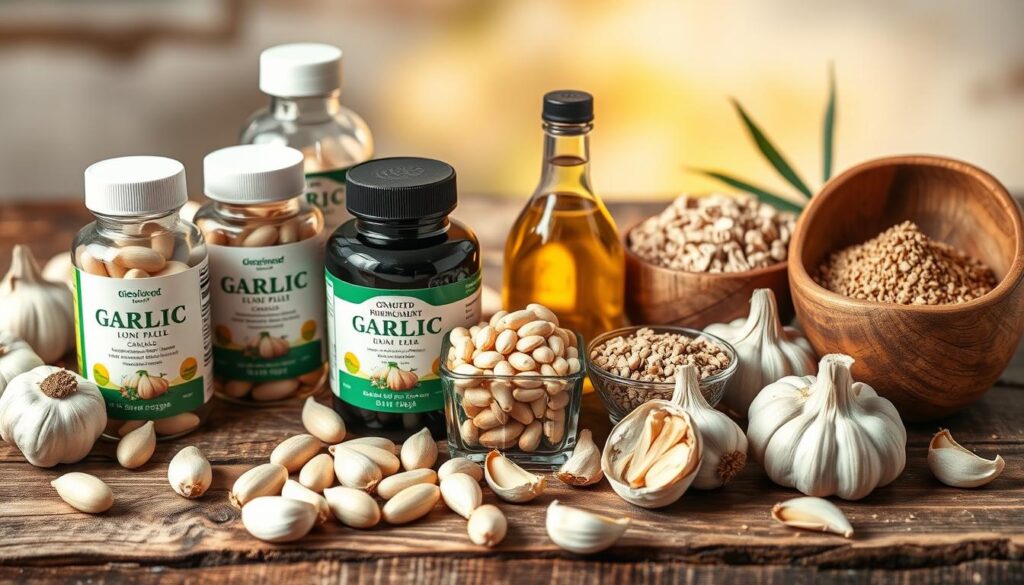
Potential Side Effects and Precautions
Garlic is usually safe in small amounts. But, it’s good to know about possible side effects and precautions. It might affect how certain medicines work, like blood thinners and diabetes drugs. Always talk to a doctor before using garlic, especially if you’re on medication or have health issues.
Some people might get stomach problems from garlic supplements, like heartburn or bloating. Rarely, garlic can cause allergic reactions, like skin rashes or diarrhoea. Watch how your body reacts and stop using it if you have any bad side effects.
Pregnant or breastfeeding women should be careful with garlic for infection or natural healing. There’s not much research on garlic’s safety during these times. Also, people with bleeding problems or those about to have surgery should not eat too much garlic. It might make bleeding more likely.
